Bihar: Assembly and council elections
This is a collection of articles archived for the excellence of their content. |
Bihar poll toppers: 1951-2010
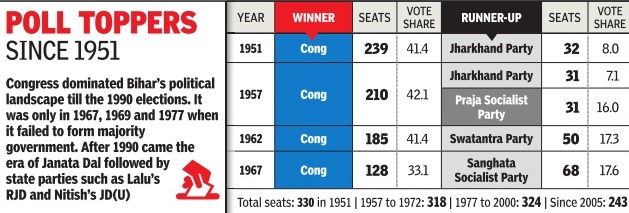
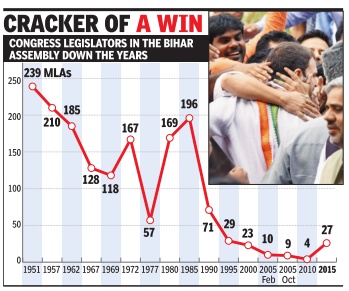
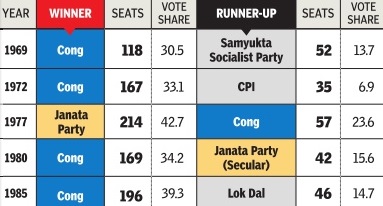
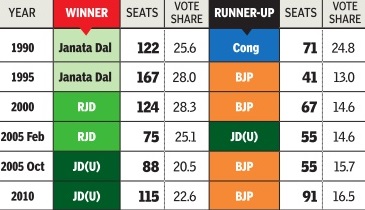
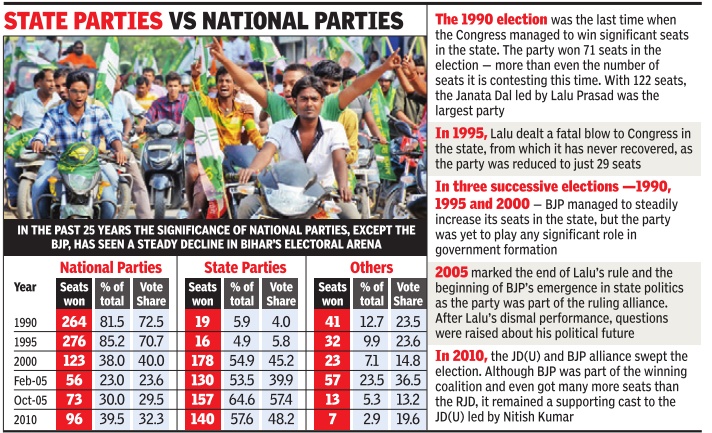
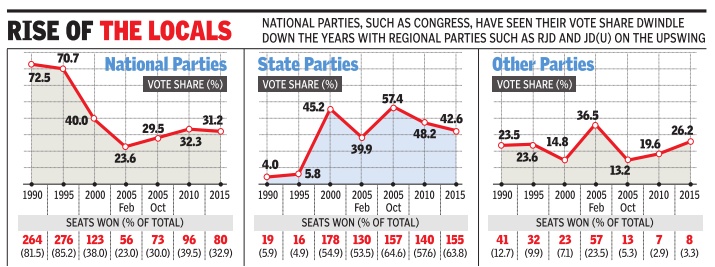


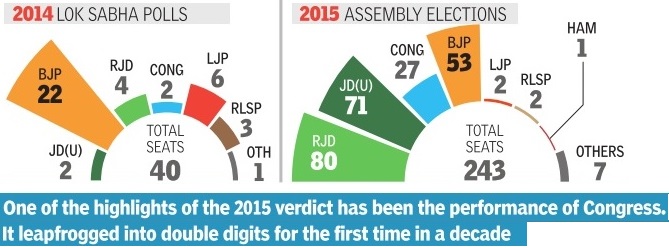
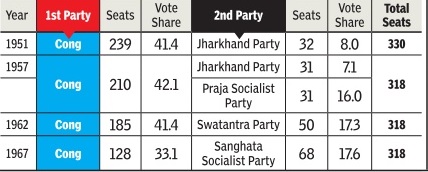
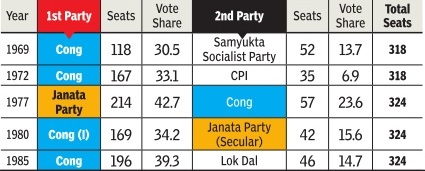
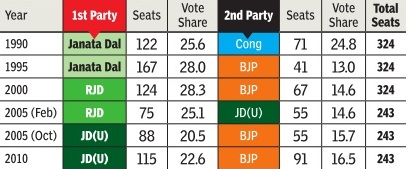

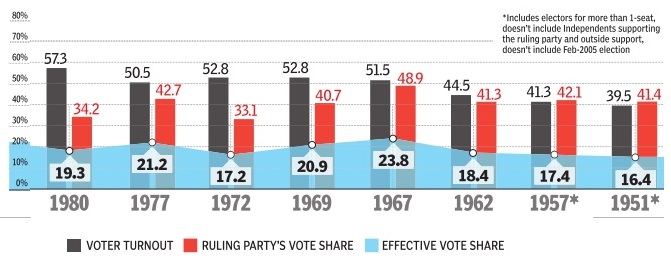

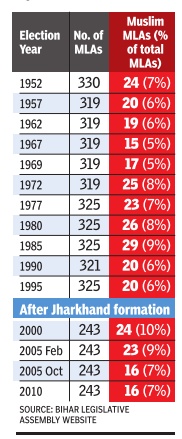

Caste composition of the Bihar Legislative Assembly
1951-2015
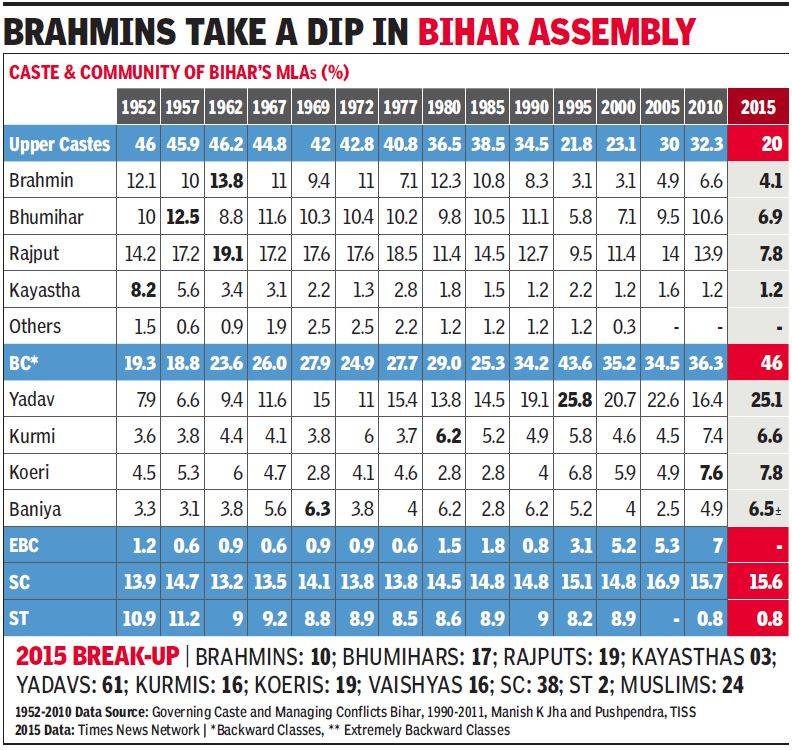
Graphic courtesy: The Times of India, November 10, 2015
See graphic:
Caste composition of the Bihar Legislative Assembly, 1951-2015
The winning parties
1951-2015

From: November 11, 2020: The Times of India
See graphic:
Bihar assembly elections, 1951-2015: The winning parties
Bihar, Election trends, Assembly and Lok Sabha
2005-2014
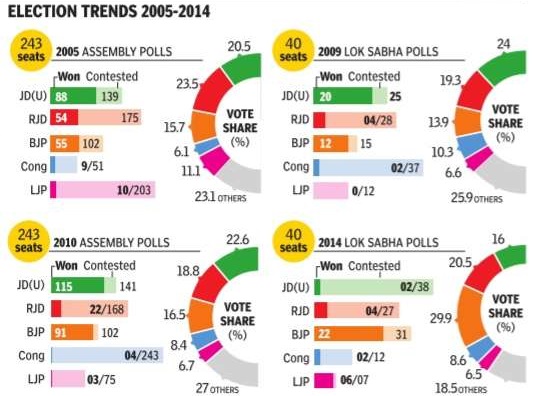
Graphic courtesy: The Times of India

Graphic courtesy: The Times of India
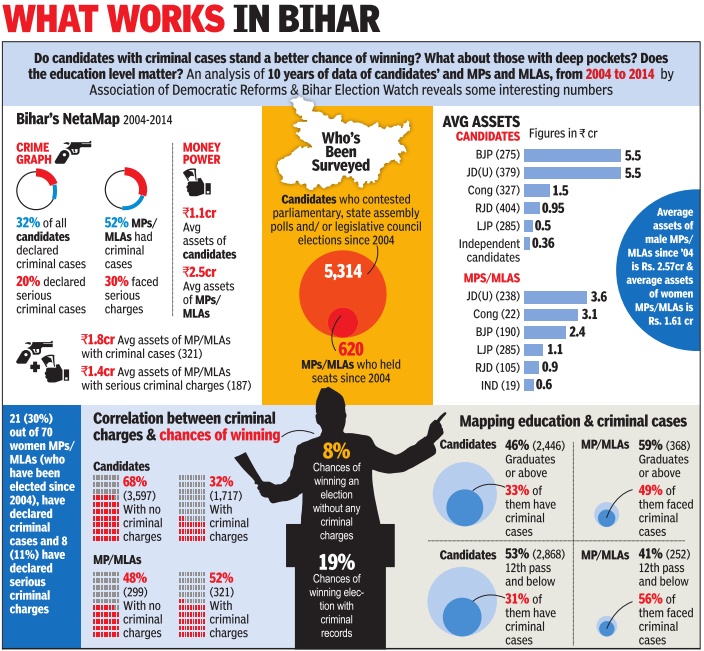
Graphic courtesy: The Times of India, September 21, 2015
See graphics:
Bihar: Election trends, 2005-2014 (assembly, Lok Sabha)
Bihar: Performance of SC and ST candidates in the 2005 and 2010 Assembly Elections
MPs and MLAs, Bihar, 2004-14
Legislative council_elections
2022
April 8, 2022: The Times of India
Patna: The National Democratic Alliance (NDA) has emerged as a big winner in the biennial elections to 24 legislative council seats from the urban local bodies and panchayati raj institutionsin the state, as it won at least 12 seats till the time of going to press, reports Abhay Singh. The battle turned cliffhanger in three constituencies and their results were awaited till late evening.
RJD, led by Lalu Prasad, won five of the 23 seats it contested, while Congress secured one seat. Three other seats went to the kitty of independent candidates.
On an average, the individual winning counts of the three major parties is almost the same — BJP six and JD(U) and RJD five each.
From the NDA side, RLJP led by Union minister Pashupati Kumar Paras won the lone Vaishali seat it contested. Congress won one seat. The singular uptake of the elections is that RJD, by winning five seats, will now have the status of lead opposition party, and former CM Rabri Devi will get the status of leader of opposition in the Upper House.
2010: Bihar Assembly election

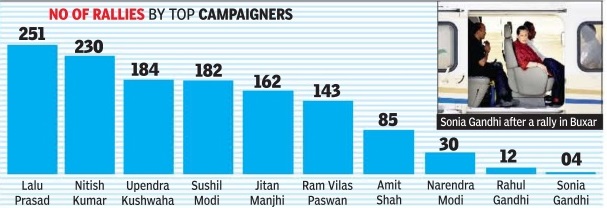

2010 elections: Victory margins
The Times of India, Oct 06 2015
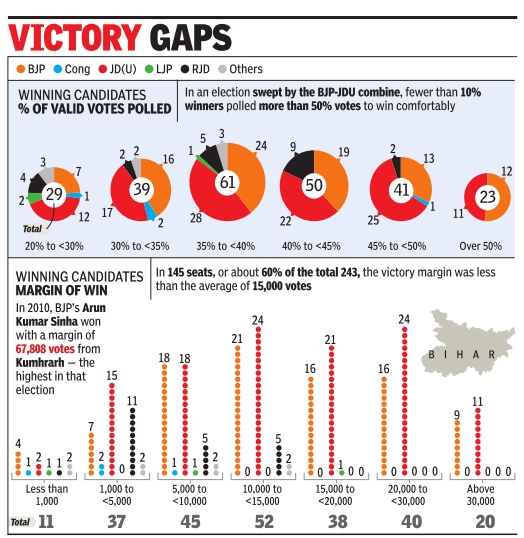
Atul Thakur 48 seats saw win margins under 5k in 1010
Several close calls can add up to an electoral sweep
Even a contest that is largely bipolar and pro duces a decisive verdict in a state need not produce decisive mandates from seat to seat, as the 2010 polls in Bihar illustrate. An analysis of the 2010 results shows that the onesided verdict in which the JD(U)-BJP combine won 206 of the 243 seats against just 25 for the RJD-LJP alliance nevertheless saw a lot of close seat level contests.
In fact, the winning candidate got a majority of the votes polled in less than 10% of the seats. BJP won in 12 of these constituencies while JD (U) won 11. There were another 91 constituencies where the winning candidate polled between 40% and 50% of the valid votes.Of these, 47 seats went to the JD (U) while the BJP and RJD won in 32 and 11 such seats respectively .
It is interesting to note that in more than half the seats in a largely bipolar contest the winning candidate got less than 40% of the votes. Indeed, there were 29 constituencies where the winner got less than even 30% of the votes polled. Despite sweeping the elections, the winning candidates of the JD(U)-BJP alliance were more or less evenly distributed across all these ranges.
The closeness of the contests at the seat level is revealed also in the victory margins in the 2010 elections. There were 48 constituencies where the victory margin was less than 5,000 votes. The JD(U) won 17 of these seats, the RJD 12 and BJP 11.This clearly sugBATTL gests that even a marginal swing in BI the votes could have thrown up a significantly different outcome in terms of party tallies, though the overall re sult would not have changed.
The average margin was about 15,000 votes. In 145 seats, or about 60% of the total, the vic tory margin was less than this average of 15,000 votes. Interest ingly, in the 98 conEGROUND stituencies where HAR the margin was higher than the av erage the winning alliance was successful in all but one.
It is also instructive to note that despite the essentially bipolar nature of the contest, 35.4% of the votes polled did not go to either of the two major combines.The Congress won 8.4% and smaller parties and independents mopped up a sizeable 27%.
Clearly, therefore, what is bipolar at the state-wide level can become quite multi-cornered at the micro level. That explains why so much effort goes into micro managing the details.
58% MLAs face criminal charges
The Times of India, November 10, 2015
Pranava Kumar Chaudhary
Altogether 142 (58%) of the 243 MLAs elected in 2015 face criminal charges. RJD tops the list with 46 out of its 80 MLAs in that category. The total figure is 1% up compared to 57% in 2010 assembly election. One MLA has declared himself illiterate while 93 (38%) are 5th to 12th pass, 138 (57%) graduate or above and nine are simply literate. Altogether 80 MLAs have been re-elected.
Poonam Devi Yadav, who has been elected from Khagaria on a JD(U) ticket, is the richest among the MLAs with total assets worth over Rs 41 crore. The average assets per MLA elected this time is Rs 3.02 crore. In 2010, it was only Rs 82.46 lakh.
According to Bihar Election Watch (BEW) and Association for Democratic Reforms (ADR) analysis based on the MLAs' affidavits submitted with their nomination papers, 98 (40%) have serious criminal cases like murder, attempt to murder, creating communal disharmony, kidnapping and crime against women pending against them.
Out of the 142 MLAs facing criminal cases, 70 (49%) have already been chargesheeted. RJD MLA from Jhanjharpur Gulab Yadav has declared one rape case pending against him, said BEW state coordinator Rajiv Kumar. Ten MLAs have kidnapping cases pending against them. Anant Kumar Singh, an Independent MLA from Mokama in Patna district, has declared two cases of kidnapping or abduction for murder against him, Kumar said.
Party-wise, 46 out of 80 MLAs from RJD (58%), 37 (52%) out of 71 from JD(U), 34 (64%) out of 53 from BJP, 16 (59%) out of 27 from Congress, all the three (100%) from CPI(ML), one (50%) out of two from RLSP and both (100%) from LJP face criminal charges. READ ALSO:
In 5 years, Bihar MLAs' wealth rose how much?
The top three richest MLAs are Poonam Devi Yadav of JD(U) from Khagaria with assets over Rs 41 crore followed by Congress MLA from Bhagalpur Ajeet Sharma (Rs 40 crore) and independent MLA from Mokama Anant Kumar Singh (over Rs 28 crore).
According to the report, Achmit Rishideo of JD(U) from Raniganj in Araria has the lowest assets of only worth Rs 9 lakh. Satyadeo Ram of CPI(ML) from Darauli in Siwan has assets worth more than Rs 11 lakh while Shyam Bahadur Singh of JD(U) from Barharia in Siwan has assets worth over Rs 14 lakh.
Altogether 127 (52.2%) MLAs have declared their age between 25 and 50 years while 116 (48%) are in 51- 80 years age group.
Only 28 (11.5%) women have been elected this time against 33 (14.5%) out of 228 MLAs in 2010.
The young, the rich, the lucky

2010-15
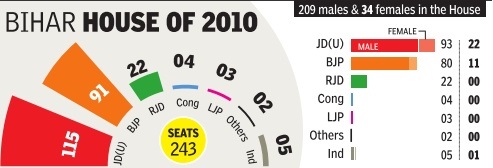

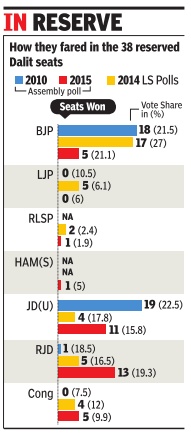

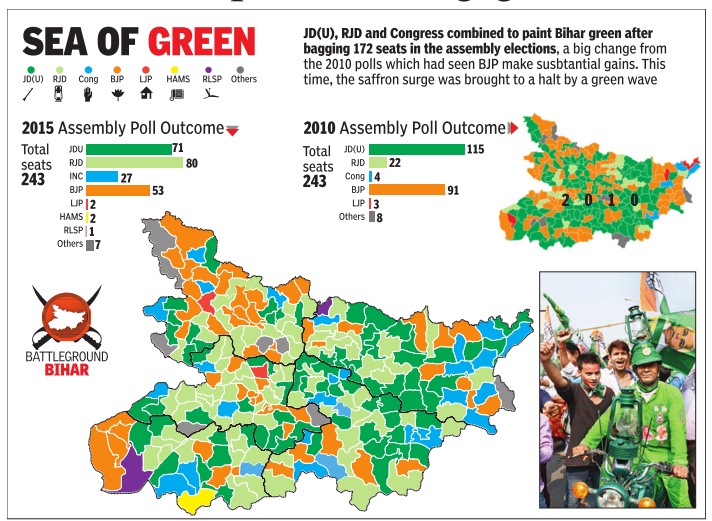

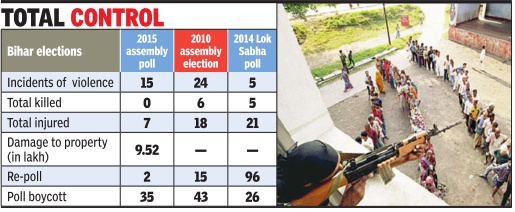
2015
See Bihar: Assembly elections, 2015
2020
The results

From: November 13, 2020: The Times of India
See graphic:
Bihar, assembly elections: 2020
Prominent Winners, Losers

From: November 12, 2020: The Times of India
See graphic:
Bihar assembly elections, 2020: The voting pattern, region- and ethnicity- wise.
|
Bihar Result Status | |||
|
Status Known For 243 out of 243 Constituencies
| |||
| Party | Won | Leading | Total |
|---|---|---|---|
| All India Majlis-E-Ittehadul Muslimeen | 5 | 0 | 5 |
| Bahujan Samaj Party | 1 | 0 | 1 |
| Bharatiya Janata Party | 74 | 0 | 74 |
| Communist Party of India | 2 | 0 | 2 |
| Communist Party of India (Marxist) | 2 | 0 | 2 |
| Communist Party of India (Marxist-Leninist) (Liberation) | 12 | 0 | 12 |
| Hindustani Awam Morcha (Secular) | 4 | 0 | 4 |
| Independent | 1 | 0 | 1 |
| Indian National Congress | 19 | 0 | 19 |
| Janata Dal (United) | 43 | 0 | 43 |
| Lok Jan Shakti Party | 1 | 0 | 1 |
| Rashtriya Janata Dal | 75 | 0 | 75 |
| Vikassheel Insaan Party | 4 | 0 | 4 |
| Total | 243 | 0 | 243 |
MGB lost by 0.03% votes
November 12, 2020: The Times of India
So near, yet so far for Tejashwi: MGB got just 0.03% votes less than NDA
For Lalu Yadav’s son Tejashwi, who turned 31 a day before the results, it was a case of so near, yet so far.
In terms of vote-share, the difference between NDA and the RJD-led Mahagathbandhan was literally wafer-thin. Complete coverage: Bihar assembly elections
At the end of a cliffhanger unlike any that India has been witness to in recent times, what separated NDA and MGB terms of the total votes they got was a mere 12,768 (out of about 3.14 crore). NDA polled 1,57,01,226 votes and MGB 1,56,88,458 votes.
That’s just 0.03% of the total votes polled in the state, with the NDA’s share being 37.26% and the MGB’s 37.23%.
It’s also considerably less than the average victory margin of 16,825 in these polls; incidentally, 130 of the state’s 243 seats were won by margins in excess of 12,768 votes.
So, if MGB had got as little as 53 more votes in each of the state’s constituencies or NDA had got that many fewer, MGB’s vote share would have been higher.
The neck and neck fight between the two alliances is in stark contrast to the one-sided contest five years ago when the Mahagathbandhan of RJD, JD(U) and Congress got 1,59,52,188 votes and the NDA of BJP, LJP, HAM (S) and RLSP got 1,29,90,645 votes, a difference of over 29.6 lakh votes or about 7.8% of the total votes polled in the state.
Tejashi-helmed RJD got the largest number of seats at 75 (also the largest vote share of 23.1%), but NDA as a whole got three more than the majority mark of 122, compared to RJD-led Mahagathbandhan’s 110.
Votes polled by parties
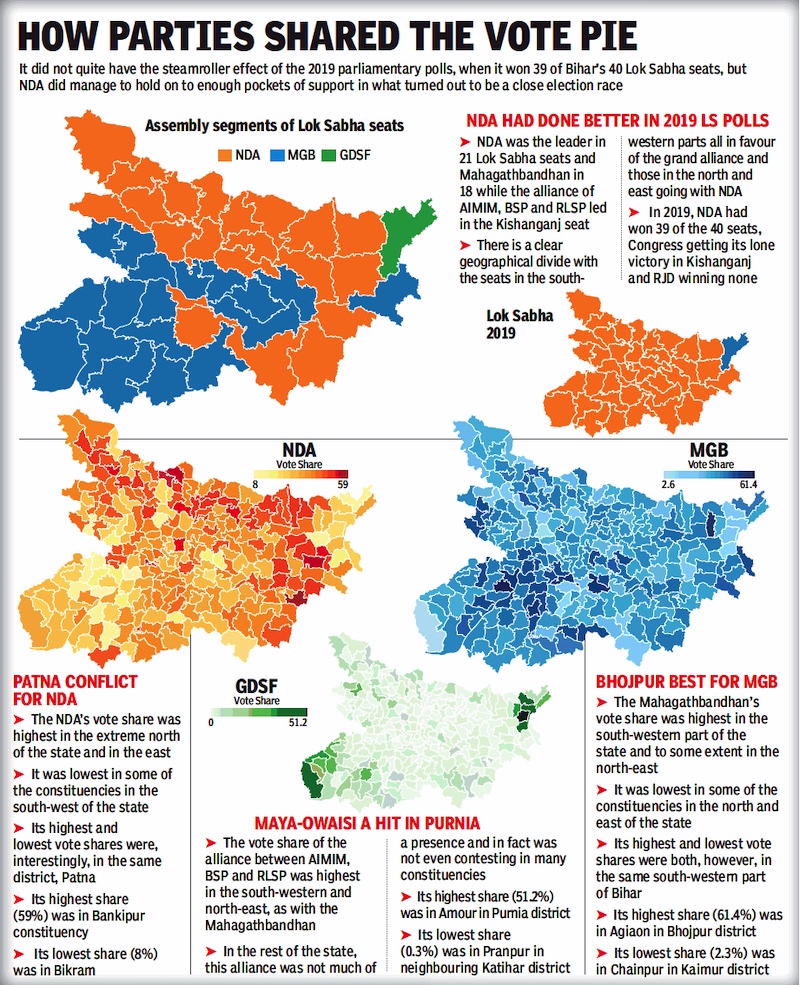
From: November 12, 2020: The Times of India
See graphic:
Votes polled by parties in the Bihar assembly elections, 2020.
Mithila dumps Cong, embraces BJP
November 12, 2020: The Times of India
Finally, Mithila voters too dump Cong, embrace BJP
New Delhi:
After a long time, Mithila and Tirhut have given BJP the same standing that was once enjoyed by Congress in Bihar politics. The emergence of Janata parties in recent decades saw Magadh and Bhojpur deciding who would hold fort in Patna, but not this time. Congress was reduced to zero in Mithila and the party managed to hold on to just three seats in Tirhut in the just-concluded assembly elections. Newbie VIP, an ally of BJP, bagged four seats in these two regions.
The National Democratic Alliance (NDA) won over 65% of its seats from these two Maithili-speaking areas. The saffron alliance’s 74 of 125 seats have come from here. BJP’s consolidation in this one-time Congress fief is significant considering that in the 2015 elections, the party had got just three seats in Mithila and 23 in Tirhut in the face of the JD(U)-RJDCongress combine.
The number of seats surged to 45 this time.
Bihar can be divided into five regions — Tirhut, Mithilanchal, Kosi-Seemanchal, Magadh and Bhojpur.
The two Maithili-speaking regions send 114 MLAs to the assembly while Bhojpur and Magadh together contribute 93 MLAs, and Kosi-Seemanchal accounts for 36.
Another significant blow to the Mahagatbandhan was delivered by the Kosi-Seemanchal region with a large Muslim vote. The grand alliance lost its edge here with RJD getting three seats and Congress six. BJP has been the gainer here too, going from seven in 2015 to 13 now.
However, Magadh and Bhojpur remain RJD strongholds, delivering 40 seats to the party which has emerged as the single largest at 75. NDA has failed to make major inroads in these two regions. JD(U) was reduced to 10 seats in Magadh and none in Bhojpur.
Hindustani Awam Morcha, Vikassheel Insaan Party
November 11, 2020: The Times of India
In Potboiler, Allies Lost & Gained Turn Plot
Manjhi’s HAM And Sahani’s VIP Add Crucial Numbers To NDA Tally That Prove Decisive
New Delhi:
The Hindustani Awam Morcha and Vikassheel Insaan Party, two lastminute entrants into the NDA fold ahead of the Bihar polls, lent a crucial helping hand to the combine as it inched towards the halfway mark.
HAM’s Jitan Ram Manjhi, a Dalit leader who became chief minister with Nitish Kumar’s blessings but soon fell out and returned to the NDA fold after failed negotiations with RJD, won his seat and his party bagged three other seats of the seven it contested.
Vikassheel Insaan Party (VIP) leader Mukesh Sahani also walked out of the RJDled camp to return to NDA and won four seats. Neither may have a great strike rate but their tallies are crucial for NDA in the light of JD (U)’s under performance.
Manjhi and Sahani delivered for the NDA on two counts — the promise to fetch the support of small communities like the Musahars and Nishads and act as a shield against Chirag Paswan — not a part of NDA this time. The presence of Manjhi helped in pre-empting the charge that JD(U) was unmindful of Dalit votes in particular.
Poll analysts said the HAM chief also consolidated Dalit votes in large swathes of eastern Bihar, helping raise NDA’s tally in many constituencies.
“What worked against Manjhi, though, was that a significant number of the seats HAM fought were given to Manjhi’s own family, sending out a parochial signal that runs contrary to what PM Modi stands for,” said political analyst Sudhir Singh. This might explain a poor strike rate.
Sahani, who made his fortunes as a contractor for lavish sets erected for Sanjay Leela Bhansali’s ‘Devdas’ developed his political ambitions while on the sets of films in Mumbai. He became a part of the NDA in 2015, but his poor performance was considered to have contributed to the defeat of the BJPled alliance.
A leader of the most backward class fishermen and boatmen in the riverine areas of the state, Sahani’s community holds sway in sizeable portions of north Bihar, where the community can tip the balance in at least a score of seats. Embraced by the BJP to add to its vote count and to send a message across to MBCs, the VIP added four seats to the NDA tally even though Sahani lost from Simri Bakhtiarpur.
MIM wins 5 seats in Seemanchal, dents MGB
Ramashankar, November 11, 2020: The Times of India
Owaisi’s MIM wins 5 seats in Seemanchal, dents MGB
Patna:
In its third attempt in the Bihar polls, the Asaduddin Owaisi-led AIMIM has managed to make its presence felt in Seemanchal region. The rise of Owaisi’s party — it has won five seats — appears to have caused substantial damage to the RJD-led Mahagathbandhan, which failed to perform on expected lines in the region.
AIMIM is now a force to reckon with in the Muslim-dominated constituencies of Seemanchal, which comprises four districts — Kishanganj, Araria, Katihar and Purnia. Kishanganj has a Muslim population of about 70%, followed by Katihar (43%), Araria (42%) and Purnia (38%). AIMIM has won Amour, Kochadhaman, Jokihat, Baisi and Bahadurganj seats. In the 2019 bypoll, AIMIM had won Kishanganj, a traditional Congress seat.
Women candidates and women voters in Bihar Assembly polls
1957-2015

Graphic courtesy: The Times of India, September 21, 2015
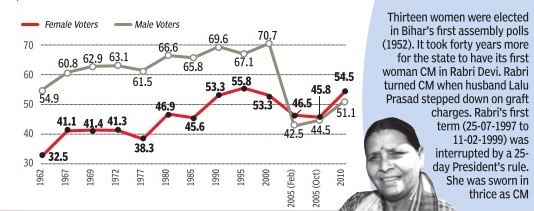
Graphic courtesy: The Times of India, September 21, 2015
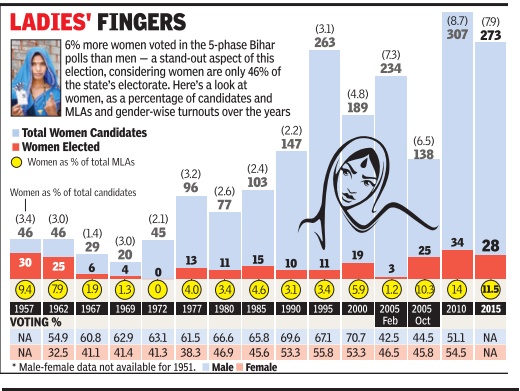
Graphic courtesy: The Times of India, November 9, 2015
See graphics:
Women candidates in Bihar Assembly, 1957-2010
Female and male voters, Bihar Assembly polls, 1962-2010
1957-2015: Women in the Bihar assembly elections: candidates, MLAs and voter turnouts